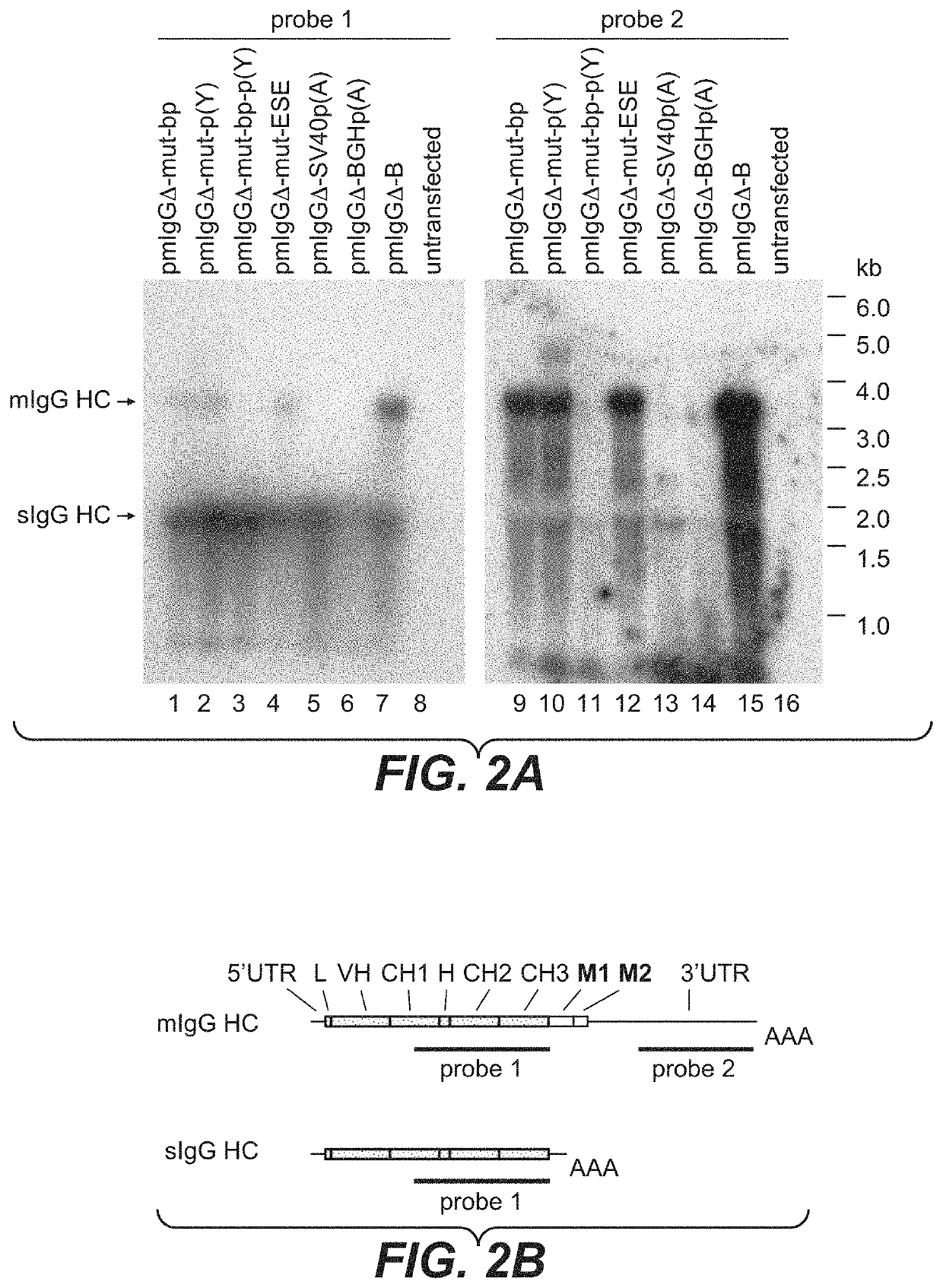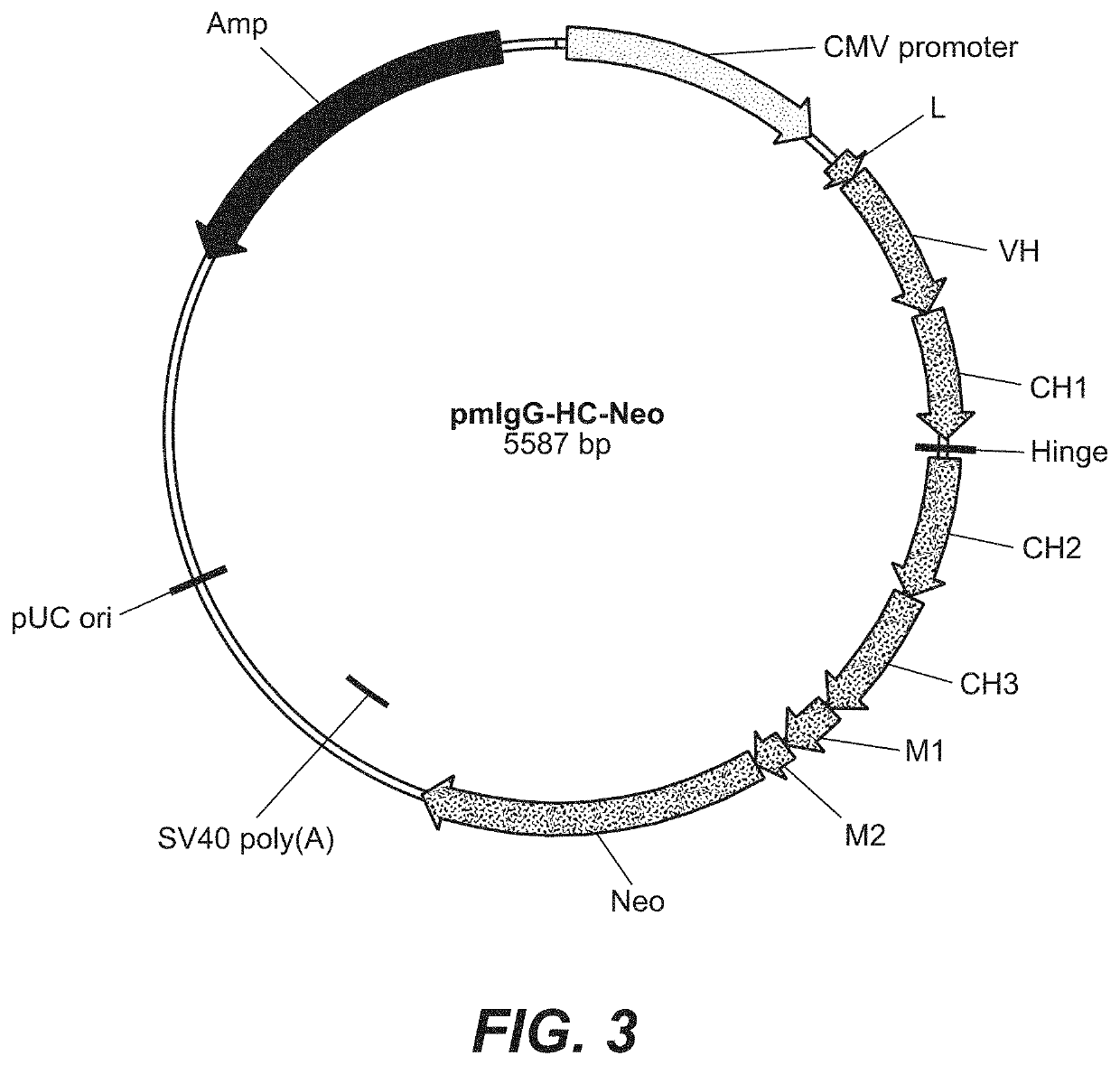Method for selecting polypeptide producing cells
a polypeptide and cell technology, applied in the field of selecting polypeptide producing cells, can solve the problems of time-consuming and consequently expensiv
- Summary
- Abstract
- Description
- Claims
- Application Information
AI Technical Summary
Benefits of technology
Problems solved by technology
Method used
Image
Examples
specific embodiments
[0364]1. A 3′-fragment of intron 6 of an immunoglobulin heavy chain structural gene that has the nucleic acid sequence CTACCACCCCCTTCCTGTCCAG (SEQ ID NO: 29) or TGACCACGCCAATCGTGTCCAG (SEQ ID NO: 14) or CTACCACGCCAATCGTGTCCAG (SEQ ID NO: 31).[0365]2. A nucleic acid that has the nucleotide sequence CTACCACCCCCTTCCTGTCCAG (SEQ ID NO: 29) or TGACCACGCCAATCGTGTCCAG (SEQ ID NO: 14) or CTACCACGCCAATCGTGTCCAG (SEQ ID NO: 31).[0366]3. A nucleic acid at the junction of intron 6 and exon M1 of an immunoglobulin heavy chain structural gene that has the nucleic acid sequence CTACCACCCCCTTCCTGTCCAGAGCTG (SEQ ID NO: 30) or TGACCACGCCAATCGTGTCCAGAGCTG (SEQ ID NO: 15) or CTACCACGCCAATCGTGTCCAGAGCTG (SEQ ID NO: 32).[0367]4. A nucleic acid that has the nucleotide sequence CTACCACCCCCTTCCTGTCCAGAGCTG (SEQ ID NO: 30) or TGACCACGCCAATCGTGTCCAGAGCTG (SEQ ID NO: 15) or CTACCACGCCAATCGTGTCCAGAGCTG (SEQ ID NO: 32).[0368]5. A nucleic acid comprising in 5′ to 3′ direction[0369]i) a first nucleic acid fragment...
example 1
[0418]Cloning of Genomic Fragments and Construction of Eukaryotic sIgG / mIgG Expression Plasmids
a) Construction of the sIgG Expression Plasmid pIgG
[0419]For the expression of an immunoglobulin with binding specificity against a proteinaceous antigen a plasmid was constructed. It codes for the secreted sIgG form of the immunoglobulin and comprises the following elements:[0420]1. A transcription unit for a human gamma (γ) 1 heavy chain, composed of[0421]the immediate early enhancer and promoter from the human cytomegalovirus (hCMV),[0422]a synthetic 5′ untranslated region including a Kozak consensus sequence (Kozak, M., Nucleic Acids Res. 15 (1987) 8125-48),[0423]a murine immunoglobulin heavy chain signal sequence including the signal sequence intron,[0424]a variable heavy chain cDNA of an antibody with binding specificity against said proteinaceous antigen,[0425]a mouse / human heavy chain hybrid intron 2 including the mouse Ig t enhancer (JH3-JH4 switch region) joined with the human im...
example 2
Transfection and Pool Selection
[0594]CHO-K1 cells (ATCC No. CCL-61; Puck, T. T., et al., J. Exp. Med. 108 (1958), 945-956), that have been pre-adapted to serum-free growth in suspension culture, were cultivated in ProCHO4-CDM medium (Cambrex), supplemented with 8 mM L-alanyl-L-glutamine (Invitrogen) and 1×HT supplement (Invitrogen), at 37° C., 5% CO2 and 95% humidity in suspension flasks. Every 3-4 days the cells are split with 2×105 cells / ml into fresh medium. For transfection, the cells are electroporated with 20 μg plasmid DNA per 7.5×106 cells in a total volume of 200 μl PBS at room temperature. The electroporations are performed with a Gene Pulser XCell electroporation device (BioRad) in a 2 mm gap cuvette, using a square wave protocol with a single 160 V pulse for 15 ms. The cells were transfected with the linearized plasmids pmIgGΔ-mut-bp, pmIgGΔ-mut-p(Y), pmIgGΔ-mut-bp-p(Y), pmIgGΔ-mut-ESE, pmIgGΔ-SV40p(A), pmIgGΔ-BGH-p(A) or pmIgGΔ-B, respectively. Afterwards the cells of e...
PUM
| Property | Measurement | Unit |
|---|---|---|
| volume | aaaaa | aaaaa |
| humidity | aaaaa | aaaaa |
| humidity | aaaaa | aaaaa |
Abstract
Description
Claims
Application Information
 Login to View More
Login to View More - R&D
- Intellectual Property
- Life Sciences
- Materials
- Tech Scout
- Unparalleled Data Quality
- Higher Quality Content
- 60% Fewer Hallucinations
Browse by: Latest US Patents, China's latest patents, Technical Efficacy Thesaurus, Application Domain, Technology Topic, Popular Technical Reports.
© 2025 PatSnap. All rights reserved.Legal|Privacy policy|Modern Slavery Act Transparency Statement|Sitemap|About US| Contact US: help@patsnap.com



